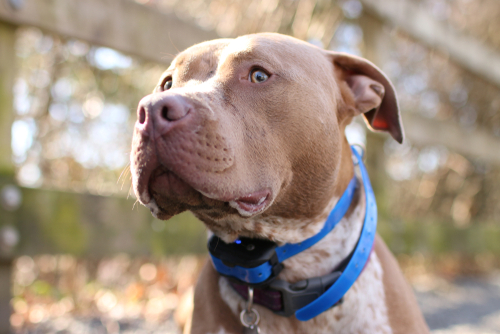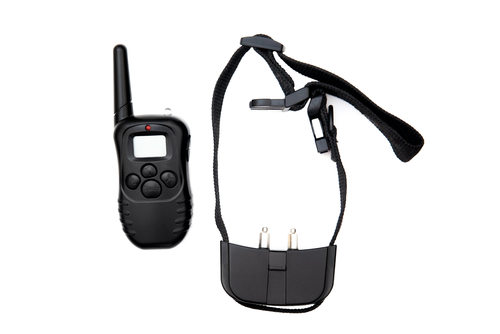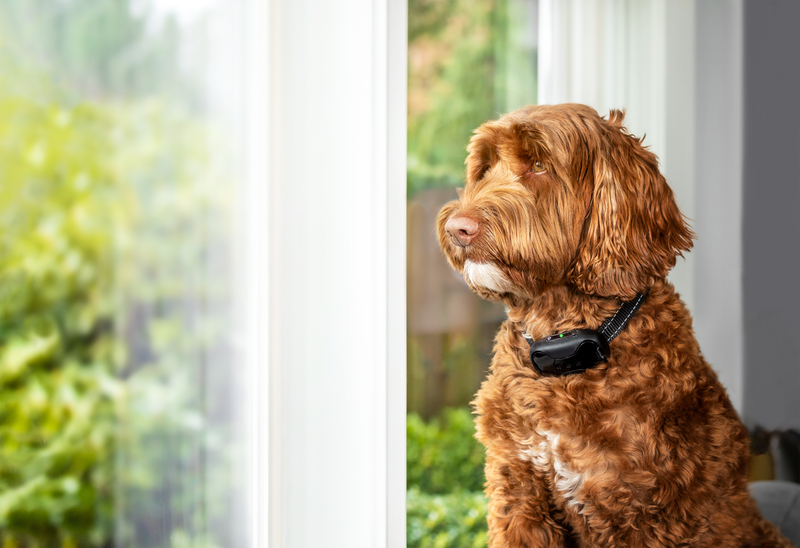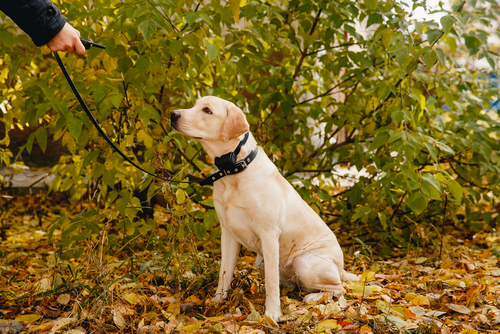The Dangers of Dog Shock Collars
Posted: 12/05/2022 | BY: Erin Cain | Categories: Behavior , Dog , Pet care
A dog shock collar is a training device that delivers an electric shock to a dog’s neck. It is used as reinforcement to train a dog to stop certain behaviors, such as barking or pulling on a leash. However, there are many dangers associated with these devices, which is why pup parents should think carefully before using them on their dogs. Here are five reasons why dog shock collars are dangerous to dogs.

What are dog shock collars?
Shock collars for dogs, also known as “e-collars,” have been gaining popularity as a training tool. Initially, shock collars were used to train hunting dogs in the 1960s. Today, people often use them for different purposes, including curbing excessive barking or food aggression. Some dog owners use this collar to teach their puppy where to stay while off-leash indoors so they don’t have any accidents.
However, there is growing evidence that these devices can do more harm than good. The use of shock collars has been banned in several countries due to the potential for abuse.

Shock collars deliver an electric shock of varying intensity to your dog when triggered by a remote control or an automatic mechanism, such as a barking sensor. The shock’s power can alter, but it can be painful and cause fear and anxiety in your dog. This fear, in turn, can amplify a dog’s destructive behaviors. Even worse, sometimes dogs won’t associate their bad behavior with the shocks, so these devices will have little effect.
There are three main types of deterrent collars: static, citronella, and ultrasonic. Static collars are the most common type and deliver a continuous shock until the button on the remote is released. Citronella collars emit a spray of citronella when triggered. In contrast, ultrasonic collars emit a high-pitched noise to startle your dog.

The dangers of dog shock collars
Despite their popularity amongst some dog owners and trainers, there are many dangers associated with dog shock collars. Here are five reasons why you shouldn’t use one:
1. Dog shock collars can cause physical pain and injuries.
Shock collars can cause burns, skin irritation, and even open wounds from electric shocks. In addition, the tight-fitting collars can restrict your dog’s breathing and cause neck injuries. Aside from burns, the electric shock delivered by a dog shock collar can cause muscle damage, thyroid damage, neck injuries, eye, and ear damage, and even cardiac arrest. In short, shock collars can harm a dog physically, mentally, and emotionally.
2. They can cause psychological damage.
Receiving electric shocks can be highly traumatizing to dogs and can lead to problems such as anxiety, aggression, and fearfulness. The use of dog shock collars has increased anxiety levels in dogs. Dogs constantly subjected to this punishment may become withdrawn and unresponsive to any training.
The potential for electric shock is a significant concern regarding automatic bark collars and fences. The device will deliver an unexpected burst of power if your dog barks too quickly or continuously. Still, the owner must turn off the collar beforehand to prevent this situation. The result is a dog who could be inadvertently shocked repeatedly, furthering psychological distress.

3. Dog shock collars are ineffective in the long run.
Shock collars may stop a dog from barking or pulling on a leash in the short term. Still, they do nothing to address the underlying behavioral issues that are causing these problems in the first place. They may even make these issues worse in the long run by causing psychological damage.
Some people believe that using shock collars for dogs is an excellent solution if your pup stops committing the behaviors that cause him to be shocked. However, this doesn’t get to the root of the behavioral problem and, therefore, will only resolve the situation partially, if at all.
The dog learns that if it does something wrong, like jumping on people or eating your favorite shoes (or even being generally bad), the collar will shock them. Unfortunately, the collar does not show the dog what behavior is desired; in most cases, the unwanted behavior returns when the collar is removed.
4. There are safer and more humane alternatives available.
Many other training methods are much safer and more humane than a shock collar. These include positive reinforcement techniques such as rewards-based training, which has been proven to be much more effective in the long run while being kinder to dogs.
Positive reinforcement is an effective training method for pets because it focuses on rewarding good behavior instead of punishing wrong actions. The idea is to reward your dog with a toy, game, or treat when he does something right. Some people think this sounds like bribery instead of animal learning, but there’s scientific research behind this effective method. Here are some positive reinforcement examples you can try with your dog:
- Use direct, short commands (“sit,” “stay,” “good,” “leave it,” “come,” etc.
- Reward your pup immediately after good behavior
- Keep training sessions fun and short
- Use consistent cues and commands
- Try a dog-training clicker
Teaching your pup desired behaviors becomes much easier with positive reinforcement methods. Your dog can understand what you expect from him and earn your praise and a treat as a reward.

5. Dog shock collars can jeopardize your relationship with your dog.
Using a shock collar can damage the bond between you and your dog, making it harder for you to trust each other and work together effectively.
We all know that dogs are loyal creatures and deserve our love. However, once your dog starts associating their favorite person with a painful experience, he might become fearful and confused because he knows you as his protector.
It’s important to remember that your dog is not trying to be difficult on purpose; they’re just acting on instinct or following their natural inclinations. Training should build trust and understanding between you and your furry friend, not break it down with fear and pain.

Conclusion
Dog shock collars may seem like an easy way to train your pup. Still, they come with many physical and psychological risks that far outweigh any potential benefits. Like many pup parents, you’re looking for a safe and effective way to train your dog. In that case, consider using positive reinforcement methods instead of relying on deterrents through electric shocks. Your relationship with your dog is too important to risk damaging it with something as harmful as a shock collar.
Does your dog need a pet insurance policy? Emergencies happen, but you and your pup can be prepared for anything with pet insurance. You can get a free quote for your dog today, and start protecting him tomorrow.
References:
- Kerns, N. (2020). Using Shock Collars for Dog Training — Is It Ok? Retrieved from https://blog.healthypawspetinsurance.com/shock-training-or-e-collars-can-hurt-your-dog-and-your-relationship-with-them
- Quinn, O. (2022). Are Dog Shock Collars Illegal in the US. Retrieved from https://pupspal.com/are-dog-shock-collars-illegal-us/
- Reed, S. (2022). Shock Collar Training Can Hurt Your Dog and Your Relationship with Them. Retrieved from https://blog.healthypawspetinsurance.com/shock-training-or-e-collars-can-hurt-your-dog-and-your-relationship-with-them
- Blackwell, E., Casey, R. (2006). The use of shock collars and their impact on the welfare of dogs. Retrieved from https://positively.com/files/The-Use-of-Shock-Collars-and-Their-Impact-on-the-Welfare-of-Dogs.pdf
- de Castro, A., et al. (2020). Does training method matter? Evidence for the negative impact of aversive-based methods on companion dog welfare. Retrieved from https://pubmed.ncbi.nlm.nih.gov/33326450/
Disclaimer
The information contained on this blog is intended for informational and educational purposes only and should not be construed as medical advice. It is not a substitute for professional veterinary care. Always consult with your veterinarian before making any changes to your pet's health care or treatment plan.
The authors of this blog are not veterinarians and do not claim to be experts in pet health. The information provided here is based on our own experiences and research, as well as information from reputable sources. However, we cannot guarantee the accuracy or completeness of this information.
We encourage you to do your own research and consult with your veterinarian before making any decisions about your pet's health.
Previous post
My Dog is Choking! What Do I Do?!Compare top pet insurance providers plans.
Enter your dog’s age in years and months to calculate their age equivalent to human years.
Calculate your dog’s ageEnter your cat’s age in years and months to calculate their age equivalent to human years.
Calculate your cat’s age